Photos by George Etheredge
For members of the Eastern Band of the Cherokee, heritage, health and agriculture are intertwined. However, maintaining traditional agricultural knowledge in the face of powerful economic and environmental factors has been a challenge. Cherokee is a community in flux. Decadeslong high poverty and unemployment rates are beginning to decline, but access to healthy food remains limited, and cultural values seem to be changing.
“Years ago, kids were taught to grow a garden; they were taught life skills that aren’t really taught anymore,” says Sheena Kanott, program director at Cherokee Choices, a healthy living program that was established in 2006.
According to Cherokee Choices, Cherokee adults are twice as likely to be obese as members of other racial and ethnic groups in North Carolina. In fact, according to a 2006 study from the Centers for Disease Control and Prevention, the rate of Type 2 diabetes among Cherokee men and women combined is 24 percent — more than three times the combined rate for men and women from all other racial and ethnic groups in North Carolina. And yet resources that could curb this trend — food education and access — are not always within reach.
“We have one grocery store on the boundary,” Kanott explains. “We’re technically a food desert.” For some communities within the boundary, which spans five Western North Carolina counties, getting to that one grocery store may take 30-35 minutes, Kanott adds. And yet there are plenty of fast-food options throughout. In fact, that same CDC study found that 18 percent of the Cherokee children surveyed reported eating fast food at least five times a week.
“It’s Western civilization versus our traditional Cherokee ways,” Kanott asserts, and she is not alone in this perspective — nor is she alone in her desire to change it. Several community and youth efforts are using gardens to reconnect the Cherokee people to local food, health and a collective heritage defined by knowledge of the earth.
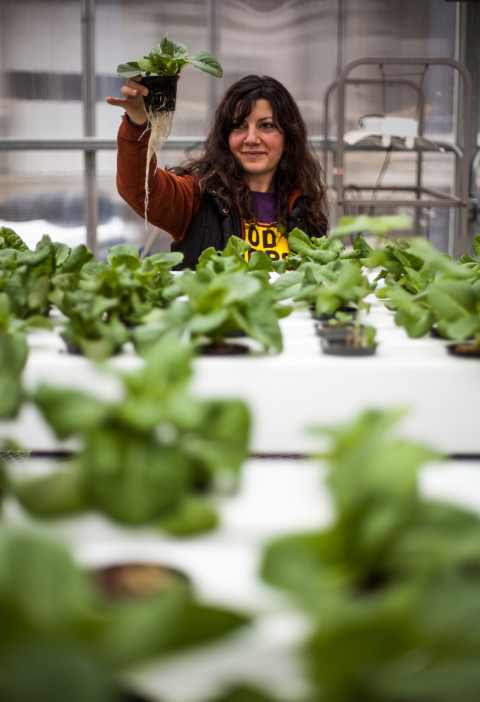
The new ‘old school’
At the foot of a sloping mountain range draped in mist, Cherokee Central School reaches across the landscape. The 473,000 square foot eco-conscious facility houses the elementary, middle and high schools, and at the far end of the extensive grounds, past the football stadium and the playgrounds, a gardening project has taken root.
The grant-funded Cherokee Choices’ Farm to School Program was launched in 2014, though the organization has been active in the public school “for over a decade,” Kanott says. “One of our goals is to get [gardening] back into the school systems and get kids thinking about where their food comes from,” she explains.
Last September, the program expanded thanks to a new alliance with FoodCorps, a branch of AmeriCorps dedicated to food education, nutrition and hands-on gardening projects. Since then, FoodCorps service members Katie Rainwater and Jordain Garretson have been hard at work in the outdoor classroom leading educational activities, maintaining the greenhouse and selecting seeds for spring planting.
“In the garden [we’re] trying to integrate both cultural and traditional knowledge as well as build a sense of ownership for the kids over growing their own food and their own health,” Rainwater explains. “The best way to do that is to get dirty.”
When Rainwater and Garretson arrived, the school had nine raised garden beds maintained by the middle school garden club (a project founded by Jessica Metz-Bugg) and a hydroponic system in the new greenhouse built by the high school’s mechanics teacher. This year the FoodCorps service members, with the help of Cherokee Choices and school staff, built the garden up into 22 raised beds, each filled with rich soil awaiting spring. Through the winter months, the hydroponic system — soon to be USDA Good Agriculture Practices-certified — provides bright, leafy greens. Once the certification is received, the greens can be used for fresh, hyper-local meals prepared in the school’s cafeteria.
“We will be taking the first step toward bringing a real-life example of farm to school,” Garretson says. “Food eaten by the students, actually grown by the students.”
In addition to the raised beds and hydroponic lettuce, the garden team hopes to plant a traditional garden with the three sisters crops — winter squash, maize and climbing beans — planted in a circle built on a mound, Rainwater adds. In the spring, the middle school garden club will plant the seeds for a pollinator garden and make labels to identity the plants in English and Cherokee.
Food education, however, doesn’t mean much unless students have access to healthy food. According to that same CDC study released in 2006, of the Cherokee kids ages 6-11 who were surveyed, 62 percent of the boys and 59 percent of the girls were overweight or obese, which the study linked to the frequent intake of fast food. However, there are indications that these numbers are improving.
A 2014 study from Johns Hopkins University found a financial link between low-income communities and higher obesity rates as nutrient-rich foods are often more expensive than unhealthy fast food. For the Eastern Band of the Cherokee, the average income of tribe members is rising thanks in part to a continued increase of the per capita annual income provided through proceeds from Harrah’s Cherokee Casino. As a result, the risk for childhood obesity is decreasing, in part because families are using their increased income to buy healthier and less-fattening foods, the study suggests.
That said, the issue of access to healthy food remains as Food Lion still serves as the boundary’s only grocery store. Additionally, 23 percent of the tribe remain at or below the poverty line, according to the Center for Native Health. As an educator, Rainwater has a lot to take into consideration. “It’s been a challenge to find a balance between saying, ‘This is healthy food,’ and what that means for you, [compared to] how you can integrate that into your life based on where your family’s at and what you have access to,” she says. “Basic access to healthy food is a hurdle in and of itself.”
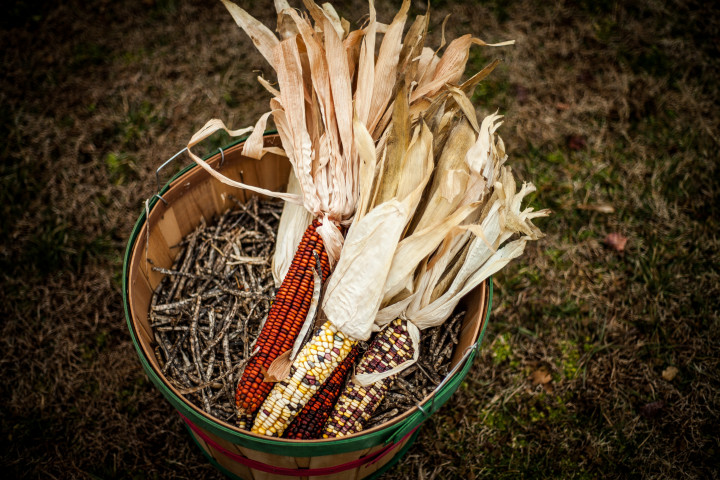
Bringing it back home
For Joey Owle, growing food is a science, a passion and an honor. When Owle graduated high school, he left the boundary to pursue environmental and soil science studies at the University of Tennessee. From there he completed a master’s program at North Carolina State University in agricultural ecology and sustainable agriculture. “Growing up here on the boundary, there’s limited opportunities for youth, so I left with a sense that, ‘I’m not coming back,'” Owle says.
But after years away, Owle realized he needed to come home. “I needed to come back to my community and give back,” he explains. “It was from being away that my sense of belonging and purpose coalesced. I knew what I had and what I valued, and it felt so good to come home.”
Today, Owle coordinates Cherokee Choices’ Farm to School Program as well as the organization’s Healthy Roots Project, a youth gardening intensive at Kituwah Mound. At Kituwah, a 300-acre parcel leased out to tribe members, Owle has half an acre to work with. Surrounded by a range of curvy mountains, the plot extends over a plateau of seamless, flat land. Here, in a wide-open field engulfed by rolling hills, the eight-week, hands-on agricultural experience takes place. Only 13 youths — all enrolled members of the tribe — ages 12-18, are accepted into the June and July program, though the interest often exceeds the capacity. Last summer 44 applications were submitted, Owle notes.
“My goal was to look at sustainable, organic management strategies for the crops [and] incorporate traditional practices as we’re out there gardening,” Owle says. “We’re an agrarian people, and growing food and managing the forest is what we did. We teach the business aspect of it too — all the gardeners participated in running our farmers market stand where they had the opportunity to sell what they were growing.”
Participants work four hours a day, three days a week earning $8 an hour, which they can use to buy their own clothing or school supplies in the fall. However, the experience of being outside and learning to manage the land is the most impactful element of all, Owle says. “A mother of a 14-year-old young man told me that he came home and said, ‘Mom, I’m not going to eat anything that’s not grown organically.’ Wow!,” Owle exclaims. “We’re able to impact these kids in their thinking.”
But there’s something else happening too, something taking place on a much deeper level. “We’re helping these kids practice what’s most inherent, what’s at the core of our DNA as Cherokee people,” Owle says. “And that’s growing our food and knowing our land.”
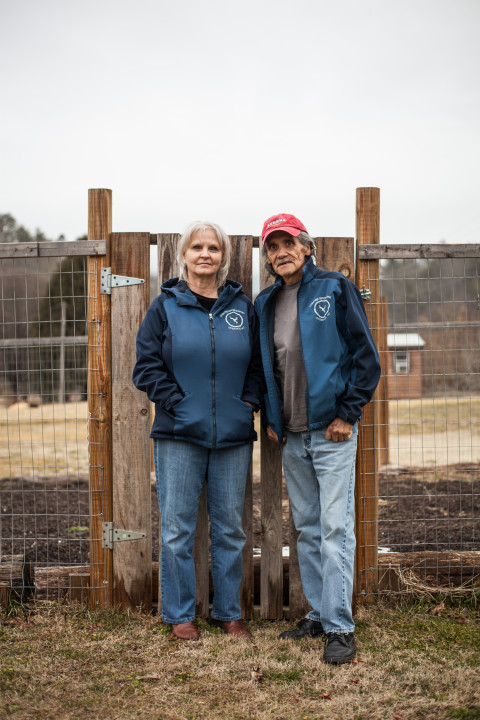
The garden that gives
Growing healthy, organic produce to feed the community is a priority for Nancy and Harold Long, heirloom seed savers, pesticide-free farmers and the founders of the Cancer Support House organic community garden. The house that hosts the support center was donated by the tribe to provide for people undergoing cancer treatment at the Cherokee Indian Hospital. The house features a guest bedroom for patients commuting to the hospital from outlying counties, a fitting room where wigs are custom-made and a full kitchen.
But the house offers one more, very important feature — the small raised garden bed in the backyard. In the heart of winter, the humble plot might not look like much, but in summer it provides more yield than you may expect. Last year, Harold hauled in the logs that frame the garden bed. He fenced its circumference with tall wire to keep critters out. He tilled in the rich compost and planted most of the seeds himself. In the growing season, the garden produced yellow crooknecks, tomatoes, cucumbers and heirloom pole beans like October Beans, Cherokee Trail of Tears Beans and Lazy Housewife Beans, which wound their way up the garden’s fence.
Volunteers and cancer patients work together in the garden, sharing the work as well as the garden’s beauty and its bounty. Produce is delivered to the homes of local cancer patients as a way to “reach out and check in,” Nancy explains. The rest of the harvest is dished up for meals served at monthly potluck suppers. Alice Dyer, a volunteer and recovering cancer patient, laughs as she says, “We had squash casseroles out of the left and right.”
As a volunteer, Dyer counsels people through their treatment — she listens, shares stories and offers support. “If you’ve ever been through cancer you more or less know what the next person’s going to deal with,” Dyer says. “I’m so eternally grateful that God has given me this time to work with people. And I love to watch people eat. I love to make sure people got enough food to eat.”
Harold, a cancer survivor, has endured seven separate primary tumors of the throat. The many surgeries and battles have left his voice ragged and garbled, and he communicates now with help from Nancy, who sometimes serves as his voice. The strength of his spirit, however, is untouched.
In Harold’s childhood home in Cherokee, he explains, subsistence farming was the way of life. “That’s how we did things,” he says. “My mom and Dad canned everything.” Nancy adds, speaking for Harold, “They grew everything organically because they couldn’t afford the fertilizers and things like that. They raised animals too. It was all in a cycle.”
This spring will be only the second year for the garden at the Cancer House, but already is has become a valuable form of therapy for the house patients, as well as the volunteers. Looking to Harold, Nancy smiles and adds, “It just brought a lot of people together.”
Roots that run deep
Cherokee heritage and growing food are inseparable, asserts Kevin Welch, founder of the Center for Cherokee Plants. “We’re an agrarian society,” he says. “Our culture is based on agriculture.”
For the past 11 years, Welch and his wife Sarah McClellan Welch, both agents at the Cherokee Cooperative Extension office, have worked to preserve traditional Cherokee heirloom seeds. As part of their work, they have also facilitate Chief Michell Hicks‘ garden-starter kits, whereby 750 families receive heirlooms seeds for free. That initiative has ensured that heritage crops are widely distributed, grown and saved in the tribal community. As Sarah describes, the center’s overall mission is simple: “To provide opportunities for families to try foods that might be new, to get families growing gardens again and to talk about their agricultural history.”
According to Kevin, the majority of traditional Cherokee foods were plant-based, and wild food foraging played an equal part in nourishing and feeding the Cherokee Nation. “Wild gathering of greens and plants isn’t considered separate [from farming],” he explains. “You go get greens in the spring when the sochan’s coming up, then you get your bean salad, ramps and poke salad. There’s a nutritional aspect of those greens. They’re provided at a time before your garden-variety plants come up and bear fruit.”
In addition to wild greens, traditionally the Cherokee harvested herbs, roots and barks for medicinal formulas, of which the recipes are guarded by the elders of the community, Kevin says. These formulas are considered medicine, whereas healthy diet and nutrition are seen as ways of maintaining health.
“Cherokees ate a high-fiber diet because it kept your body’s system healthy,” Kevin adds. “The things that are added to it, the plants that help boost your health — like yellow root for a toothache — allow the body to do its work. In true traditional culture, sickness was viewed as an entity. … It comes to you, it is an unwelcome visitor. If your body is strong and centered, then it doesn’t want to stay.”
Kevin adds that he wants to see agricultural knowledge strengthen in the tribe. To Cherokee youths, he will ask a question: “You’re Cherokee, what does that mean to you?” He says they often respond, “I don’t know, I get a per-cap check.”
“Well, no,” Kevin says. “That’s not it. Being Cherokee is who you are and the societal influences that you have and where you come from.”
Kevin says its crucial to provide children with the skills they need to grow food — and through those skills reconnect them to their roots. “The way I explain it to parents is very simple: You can plant a garden for a kid, and they’ll look at it and say, ‘That’s nice,’ and go about their business. But if you teach a kid to plant and you give them the seeds — and personally I don’t care if they put them all in one hole or if they spread them out and it looks like a drunk snake crawling across the sand — they take ownership of those plants.”
Once that happens, Kevin adds, the youths “refer to those plants as ‘my plants,’ and they now have a life skill: the ability to grow their own food.”
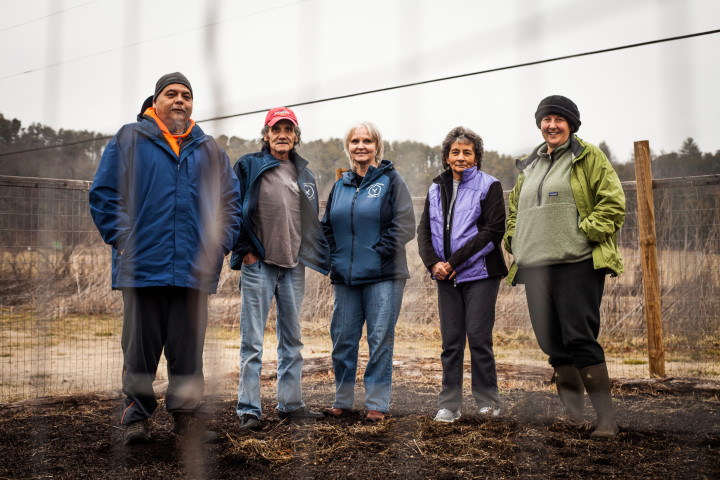
Growing forward
Afternoon sun breaks through the clouds that gathered over Cherokee Central School, as Rainwater describes the students’ reaction to their garden. Most importantly, she says, the kids are recognizing where their food really comes from.
“With first grade, we did a ‘dirt-made-my-lunch’ activity where we deconstructed lunch and every single part we traced back to the soil,” Rainwater explains. “At the start of the lesson we asked kids where their food came from and everyone said Food Lion, but by the end they could tell you, yes it did come from Food Lion but it came from somewhere [before that].”
Garretson adds that providing hands-on experiences with real knowledge about real food also “gives students the potential power to make change within their own daily food decisions, and influence their family’s choices, for the best interest of everyone.”
Empowering children and families to make those decisions is a central goal of FoodCorps, Rainwater adds, and exactly what so many are working to see in the community. “Connecting kids to real food and this kind of work, to me, is laying the foundation for a healthier community in general.”
This story is part of our series exploring farming in minority or otherwise marginalized communities. Xpress will continue exploring this topic throughout the growing season.


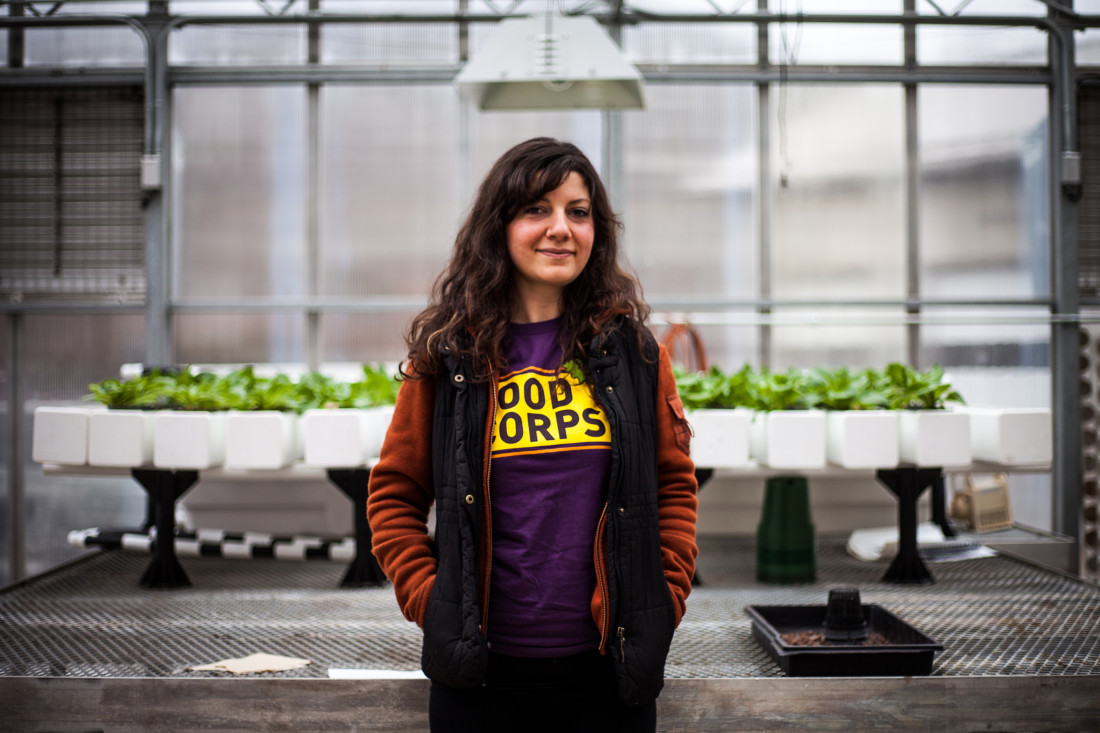
Before you comment
The comments section is here to provide a platform for civil dialogue on the issues we face together as a local community. Xpress is committed to offering this platform for all voices, but when the tone of the discussion gets nasty or strays off topic, we believe many people choose not to participate. Xpress editors are determined to moderate comments to ensure a constructive interchange is maintained. All comments judged not to be in keeping with the spirit of civil discourse will be removed and repeat violators will be banned. See here for our terms of service. Thank you for being part of this effort to promote respectful discussion.